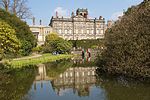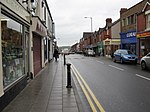Biddulph Moor
BiddulphStaffordshire geography stubsTowns and villages of the Peak DistrictVillages in Staffordshire

Biddulph Moor is a village located on the hill which bears the same name. It is in Biddulph parish and is a part of the Staffordshire Moorlands district in England. It is very similar to Mow Cop which is located on the other side of the valley of Biddulph. It is semi-rural and is the source of the River Trent.
Excerpt from the Wikipedia article Biddulph Moor (License: CC BY-SA 3.0, Authors, Images).Biddulph Moor
Alders Road, Staffordshire Moorlands
Geographical coordinates (GPS) Address Nearby Places Show on map
Geographical coordinates (GPS)
| Latitude | Longitude |
|---|---|
| N 53.12 ° | E -2.1413888888889 ° |
Address
Alders Road
Alders Road
ST8 7LT Staffordshire Moorlands
England, United Kingdom
Open on Google Maps







